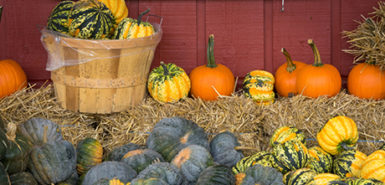
You have just made up your mind to eat healthier. You walk to your kitchen and fling open the doors to the cupboards and refrigerator. You purge them of anything in the form of a chip, cookie, donut or cracker.
In the aftermath of ridding your kitchen and your life of those unhealthy foods, a single thought clouds your mind:
Now what?
This is the point in your journey that can either pave the way to a healthier lifestyle or send you back to the snack aisle. Making the decision to eat healthy is the easy part. Physically starting and then maintaining that healthy lifestyle can be more of a challenge.
Steel yourself with these 5 tips to make your health journey easier:
1. Be cautious of any ‘diet’
Registered dietitian Kayla Knight says that “diet” is nothing more than another ugly four-letter word that has unfortunately been accepted in our society.
The problem she has with diets is that the majority of them tend to exclude or greatly limit entire food groups (or at least a good majority).
Remember the Atkins diet? The premise of this diet was to promote weight loss by breaking down the fat in our body instead of our blood sugar. Sounds innocent enough, right?
Dr. Atkins, however, took the typical carbohydrate-dependent diet and changed it so fats are the largest nutrient consumed. This means that fruits, vegetables and whole grains make up only a small part of our diets while foods like meat and cheeses are the main focus.
Off the bat this should raise some red flags (did you see the latest research linking red and processed meat with cancer).
Another problem with diets is the negative effects they have on the body.
“‘Yo-yoing’ is a term that describes the constant cycle of weight loss and weight gain the body goes through when following extreme diets,” Knight said. “What you should strive for is a lifestyle change that includes a variety of nutritious foods—not an overnight fix.”
2. The less processed the better
A general rule of thumb is that foods with the least amount of processing are best. This rule can be applied to essentially every food group.
One example is rice. Eating a serving of brown rice will provide more nutrients than a serving of white rice because the whole food form of rice is left intact. In the same light, eating a grilled chicken breast will be much healthier than fried chicken fingers.
Eating less processed foods includes beverages, too. Try to limit the amount of sugary drinks, including 100% juice.
What does this mean for fruits and vegetables? Are canned or frozen foods off the table?
“Not necessarily,” Knight said. “Frozen produce is usually more accessible and sometimes cheaper than buying fresh produce. Canned vegetables usually contain sodium, while canned fruits are preserved in syrup. Opt for those labeled as being ‘no salt added’ or ‘in juice’ rather than syrup.”
3. Eat a rainbow
Sorry, Knight is not referring to that colorful bag of Skittles.
“This phrase simply means to add as much variety to your meals as possible,” she said. “Since fruits and vegetables contribute the most color, it makes sense that adding more color will make for a healthier meal.”
With this in mind, try to imagine a plate dressed with fried chicken, mashed potatoes, gravy and a buttermilk biscuit. See the problem? Not only is this meal not the healthiest, but it is void of color. Tan chicken, white potatoes with brown gravy and a white biscuit does not scream excitement.
Now imagine this alternative—a baked chicken breast with a serving of mashed sweet potatoes and green beans. Better, right? There is still the tan chicken, but adding orange and green to the plate makes it more pleasing to the eye and healthier for the body.
4. Watch your portions
Let’s say that, by a miracle, you found the most delicious chocolate chip cookie recipe that happens to be vegan, gluten free or sugar free. Does that mean you should eat a dozen in one sitting?
“Sadly, no,” Knight said. “Even when eating the world’s healthiest foods, follow portion sizes. Whether or not your goal is to lose weight, paying attention to how much food you are eating not only helps you keep track of calories, but will also track the amount of nutrients you eat throughout the day.”
To help manage this goal, find an online calorie tracker as well as guidelines for how much food per food group (fruits, veggies, dairy, protein and healthy fats) should be eaten, based on your age, weight and activity level. Following these guidelines help to ensure that you get all the essential nutrients your body needs.
5. Take a breath and relax
Keep in mind that eating habits are developed over many years. You can’t expect to make such a drastic change without feeling a pang for some of your favorite junk foods.
Obsessing over calories and portion sizes to the point where you can’t enjoy what you eat can be as dangerous as overeating.
“If you strive to eat the best, most nourishing foods at each meal, having one cookie will not kill you,” Knight said. “If you are at the point in your journey where you don’t feel strong enough to resist restricting yourself to the infamous just one, then by all means stick to your limits.”
As Gretchen Rubin put it in her book on developing healthy habits, Better Than Before, “some of us, ‘abstainers’ are simply better off avoiding certain foods for life while others are somehow able to manage moderation.”
“Just remember that food should have no control over your life, but should be a means to make your life better,” Knight said.
 /a>
/a>
 /a>
/a>
 /a>
/a>
Excellent article! Think people want to eat better but don’t know what is healthy anymore…there is such a misconception about grains…so many people have cut them out under the guise of ‘cutting carbs’. There is a large void amongst people who want to eat more healthy – learning to cook grains and plant-based proteins.
Excellent article!
I have a soy (anything with a soy based ingredient), lentils and legumes. I faithfully need to read labels, but it sometimes makes it difficult to eat healthy.
Awesome 5 ways to begin good nutritious habits. Thanks for this great content, it helps a lot.